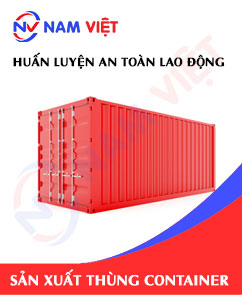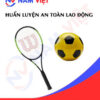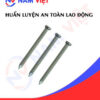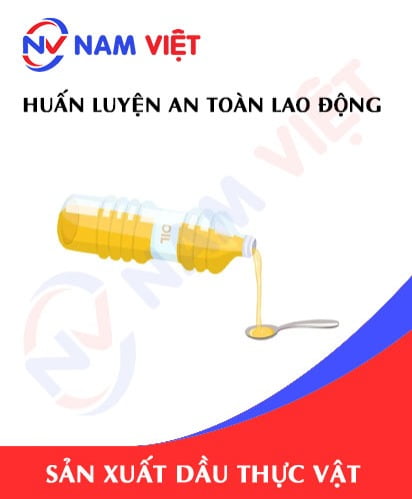Occupational Safety Training For Container Boxes Manufacturing
99,000 ₫
Note: The above price is calculated for one person, the price may fluctuate depending on the number of trainees participating in the course and the movement of the market. For more accurate pricing support, please refer to the quotation or contact directly with our consultants.
Occupational safety is an important issue in container boxes manufacturing factories and needs to be addressed promptly to ensure the health and safety of workers, as well as to enhance the reputation of enterprises. The Occupational Safety Training course is one of the effective solutions to raise awareness about preventing occupational accidents for workers participating in container box manufacturing.
Table of Contents
Toggle1. Overview of Container Boxes
a. What is a Container Box?
- Container boxes (also called containers) are specialized units used to transport goods by sea, rail, or road.
- Container boxes are made of steel and come with doors, locks, and other features to protect the goods inside during transportation from one place to another.
- Common container box sizes include 20 feet and 40 feet, with heights typically 8 feet or 8 feet 6 inches.
- Different types of container boxes are designed to suit various types of goods and different transportation requirements.

b. Machinery for Container Box Manufacturing
Container box manufacturing is a complex process that requires the coordination of multiple departments and machinery. Below are the main types of machinery commonly used in container box manufacturing:
- Plate cutting machine: This machine is specialized for cutting steel plates into desired sizes and shapes to be used in making container boxes.
- Plate stamping machine: This machine stamps steel plates into specific shapes and sizes for container box components.
- Spot welding machine: This machine welds the parts of container boxes together.
- Plate bending machine: This machine bends steel plates into specific shapes and sizes for container box components.
- Spray painting machine: After components are assembled and completed, this machine applies a protective paint layer on the container box surface.
- Container lifting machine: This machine is necessary for lifting and moving container boxes to required locations.
Additionally, other machinery may be used depending on the manufacturing scale and technology of each factory.

c. Container Box Manufacturing Companies in Vietnam
Container box manufacturing companies in Vietnam include:
- Vietnam Container Solution Co., Ltd.: One of the leading companies in Vietnam in manufacturing and trading various container boxes in different sizes and designs. The company is headquartered in Ho Chi Minh City with branches in other provinces nationwide.
- Thanh Long Production and Trading Co., Ltd.: Specializes in manufacturing container boxes for transportation, warehousing, and storage. Headquartered in Hai Phong City with branches in other regions.
- Nam Phuong Production and Trading Co., Ltd.: Specializes in producing high-quality container boxes to meet the needs of transportation and warehousing businesses. Headquartered in Ho Chi Minh City.
- Tay Do Production and Trading Co., Ltd.: Produces high-quality container boxes with diverse sizes and designs to meet customer needs. Headquartered in Can Tho City.
Additionally, many other companies operate in the container box manufacturing sector in Vietnam.

d. Specific Jobs in Container Box Manufacturing Factories
Group 1
- CEO, Deputy CEO, and department heads in the container box manufacturing factory.
Group 2
- Safety officers: manage factory safety, design safety procedures, supervise and ensure employees follow safe working procedures.
Group 3
- Receiving materials: Materials used in container box manufacturing include steel, aluminum, and other materials. Staff must check material quality before production.
- Cutting, bending, and welding steel: Steel is cut, bent, and welded to form parts such as base plates, columns, frames, doors, etc. These tasks are usually performed using cutting, bending, and welding machines.
- Painting and anti-corrosion coating: After cutting, bending, and welding, parts are painted and coated to protect them from weather and environmental effects.
- Assembly: Painted and coated parts are assembled into a complete product. Assembly is usually done by experienced container box manufacturing staff.
- Quality inspection: After assembly, quality control staff inspect the product to ensure it meets safety and quality standards before market release.
- Packing and transportation: After quality checks, container boxes are packed and transported to customers or distributors.
Group 4
- Office work, service, sales, marketing.
- Production management, quality management, human resources management, material management, finance and accounting management.
- Research and development of new products, designing product packaging and models.

2. Overview of Labor Safety Training for Container Box Manufacturing
In this article, we focus on issues related to Group 3, because Group 3 directly participates in production and faces the highest labor safety risks. Refer to other groups here
a. What is Group 3 Labor Safety Training?
- Group 3 Labor Safety Training consists of sessions that equip workers with knowledge on accident prevention.
- The training helps workers recognize and avoid hazards, reducing the risk of workplace accidents during work.
REGISTER FOR LABOR SAFETY TRAINING SERVICE
b. Training Duration
Initial safety training duration
- Total training hours at least 24 hours, including assessment time.
- 8 hours of theory on safety policies, regulations, and labor hygiene
- 8 hours of theory on basic labor safety and hygiene knowledge
- 4 hours of theory on specialized training content
- 2 hours of practical training on specialized content
- 2 hours of final theory examination
The safety training center schedules sessions depending on workers’ availability. Usually, there are 6 sessions over 3 days if the company can arrange continuous learning time.
Periodic safety training duration
- Before the labor safety card expires, workers must complete periodic labor safety training with periodic training hours at least 50% of the initial training duration.
Explanation: The total periodic labor safety training duration is at least 12 hours, including assessment time. Upon completion and passing the test, workers are reissued or extended their labor safety card.
c. Training Content
| No. | TRAINING CONTENT | TRAINING HOURS | |||
| Total | Including | ||||
| Theory | Practice | Examination | |||
| I | Safety Policies and Labor Hygiene Laws | 8 | 8 | 0 | 0 |
| 1 | Overview of legal documents system on labor safety and hygiene. | 6 | 6 | ||
| 2 | System of safety and hygiene technical standards and regulations. | 1 | 1 | ||
| 3 | Specific regulations of state management agencies on labor safety and hygiene when constructing, expanding, or renovating facilities for manufacturing, using, storing, and inspecting machinery, equipment, materials, and substances with strict labor safety requirements. | 1 | 1 | ||
| II | Basic Knowledge of Labor Safety and Hygiene | 8 | 8 | 0 | 0 |
| 1 | Basic knowledge of hazards and harmful factors in the workplace. | 4 | 4 | ||
| 2 | Methods for improving working conditions. | 1 | 1 | ||
| 3 | Safety culture in production and business. | 1 | 1 | ||
| 4 | Rights and obligations of employers and workers; labor safety and hygiene policies; functions of safety networks and safety officers. | 1 | 1 | ||
| 5 | Labor safety regulations, signs, and usage of safety equipment, personal protective equipment; skills in first aid, accident prevention, and occupational disease prevention. | 1 | 1 | ||
| III | Specialized Training Content | 6 | 4 | 2 | 0 |
| Comprehensive knowledge of machinery, equipment, substances generating hazardous factors; risk assessment and management of labor safety; safe working procedures with machinery, equipment, and substances requiring strict safety compliance. | 6 | 4 | 2 | ||
| IV | Final Safety Training Assessment | 2 | 2 | 0 | 0 |
| Total | 24 | 22 | 2 | ||
See more training content of the 6 groups
d. Labor Safety Card
Upon completing labor safety training and passing the examination, workers will be issued a labor safety card (commonly called Group 3 labor safety certificate).
The Group 3 safety card shows details such as name, date of birth, specific job and work environment, as well as training duration, red stamp, and signature confirming course completion.
According to regulations in Clause 2 of Article 24, Decree 44/2016/ND-CP, there are two cases:
- If there is an employment contract between the employer and employee, the employer must sign, stamp, and authenticate the safety card for the trained Group 3 worker after completing the training and passing the test.
- If the worker is freelance or temporary, without an employment contract, the training unit must sign, stamp, and authenticate the safety card after the worker completes the training and passes the test.

3. Recognizing Hazards Affecting Workers During Container Box Manufacturing
Container box manufacturing is a job that requires high professionalism and carefulness, especially in the fabrication and assembly stages. Some potential hazards for workers during container box manufacturing include:
- Hazards from equipment and machinery: During the manufacturing process, workers may come into contact with large machinery and equipment, especially during cutting, drilling, welding, operating forklifts, etc. If safety is not ensured, accidents can occur, causing injury or even death to workers.
- Hazards from materials: Container boxes are manufactured from materials such as steel, aluminum, iron, etc. These materials can pose dangers to workers, mainly during cutting, welding, or drilling operations. Smoke, dust, and UV rays can affect workers’ health.
- Hazards from heavy objects: Container box components are very heavy, so during assembly and movement, they can pose dangers to workers, especially when lifting equipment is used incorrectly.
- Hazards from electricity: If electrical equipment in the factory is not regularly maintained, lacks insulation, or is not waterproof, it can cause electric shock hazards to workers during manufacturing.
- Hazards from temperature and noise: During manufacturing, workers may be exposed to high temperatures and loud noise from machinery. High temperatures can cause burns and other injuries, while loud noise can cause permanent hearing damage.

4. Common Workplace Accidents for Workers During Container Box Manufacturing
Common workplace accidents for workers during container box manufacturing may include:
- Machinery accidents: The main hazard when working with machinery in a container box factory is machinery accidents, including entanglement, stabbing, crushing, cutting, or collision with hard objects.
- Chemical poisoning: Employees in container box factories may be poisoned when exposed to chemicals or toxic substances during manufacturing.
- Fire and explosion accidents: Due to welding, cutting, grinding, painting, and gas handling, container box factories have a high risk of fire and explosion.
- Falls and falling from height: Working at height or on lifting equipment in container box factories poses the risk of falls and falling to the ground.
- Incorrect clothing and not using protective gear: Employees not wearing full protective gear, including helmets, safety glasses, safety shoes, gloves, and masks, are at risk of serious injuries or chemical poisoning.

5. Safety Measures When Participating in Container Box Manufacturing
Safety measures when participating in container box manufacturing include:
- Use of protective equipment: Ensure full use of protective equipment such as helmets, safety glasses, cut-resistant sleeves, and safety shoes to protect workers.
- Labor safety training: Employees need to be trained on the manufacturing process, necessary safety measures, and correct use of protective equipment.
- Regular maintenance and cleaning: Manufacturing machinery needs regular maintenance to ensure safety and efficiency. Factories also need regular cleaning to reduce fire and explosion risks.
- Safety technical inspection: Engineers and safety specialists should regularly inspect machinery, equipment, materials, and production processes to ensure employee safety.
- Organize fire safety training: Factories need to regularly organize training for employees on fire prevention to minimize damage in case of incidents.
- Use safe materials and chemicals: Choose safe materials and chemicals to ensure worker and environmental safety.
- Adjust pressure and temperature: During container box manufacturing, pressure and temperature need to be monitored and adjusted to prevent accidents.
- Perform quality control: All container box products need quality inspection before leaving the factory to ensure user safety.
- Regularly conduct work environment monitoring in the factory, collect and analyze harmful factors for workers, then adjust to reduce hazards to prevent occupational diseases.
6. Benefits of Labor Safety Training in Container Box Manufacturing
An Toan Nam Viet provides your enterprise with the following benefits after completing labor safety training courses according to Decree 44/2016/ND-CP regarding occupational safety and hygiene for companies and enterprises.
- Workers can recognize potential workplace accident hazards and take preventive measures to avoid accidents.
- Your enterprise can establish risk prevention measures in production, operation, and maintenance processes.
- Minimizes costs when safety hazards occur during labor.
- Uninterrupted production helps increase labor productivity and product quality.
- Complying with labor safety laws avoids legal risks.
- Enhances credibility and professionalism in all aspects, boosting your enterprise’s brand value.
Nam Viet’s training courses are a solution to prevent external factors from affecting individuals so they can avoid dangers that could lead to injury or, in serious cases, death.
REGISTER FOR LABOR SAFETY TRAINING SERVICE
7. Customer Feedback After Completing Labor Safety Training in Container Box Manufacturing
An Toan Nam Viet has many years of experience accompanying enterprises in Vietnam in general and southern provinces in particular. This responsibility is extremely valuable to Nam Viet, which is why Nam Viet’s Labor Safety Training is increasingly professional. The motivation for An Toan Nam Viet’s growth comes from positive feedback and suggestions from enterprises. Below are some feedback from our partners.
Bac Nam E&C Construction Investment Joint Stock Company
“The first time using services at An Toan Nam Viet, I was very surprised by the 24/7 support from the consulting team. The class organization was quick and convenient for our company. Thank you very much for Nam Viet’s service!”
Hoa Dat Construction and Trading Joint Stock Company
“Nam Viet’s service has greatly helped us simplify labor safety and complete safety documentation for the working process. The consulting team is enthusiastic and timely in addressing our questions. 5 stars for Nam Viet.”
See more customer interview sessions after using the service of An Toan Nam Viet
8. Labor Safety Training Capacity of An Toan Nam Viet
An Toan Nam Viet is a reputable and high-quality labor safety training center in Vietnam. Labor safety training sessions are continuously held at factories, workshops, or construction sites across the country (all 63 provinces of Vietnam).
REGISTER FOR LABOR SAFETY TRAINING SERVICE
Labor safety training license
- An Toan Nam Viet has been inspected and certified by the Safety Department of the Ministry of Labor, Invalids, and Social Affairs and granted a certificate of eligibility for occupational safety and hygiene training. This further strengthens our labor safety training capacity.

Materials and lectures
- Before being used in labor safety training courses, the materials are reviewed to ensure lectures are accurate and effective.
- Lecturer teaching methods are standardized according to An Toan Nam Viet standards, based on expertise in occupational safety and hygiene training, to maximize knowledge absorption for trainees.
Facilities
- Controlling factors in classrooms affecting training will increase teaching efficiency and knowledge absorption.
- Training facility support provides spacious classrooms meeting standards for area, lighting, and training equipment.
9. Nationwide Reputable Labor Safety Training Center
At An Toan Nam Viet, we prioritize professional dedication to labor safety training. For us, imparting knowledge on self-protection to workers equips them with safety skills for their livelihood, contributing to national development.
To ensure effective training, we meticulously prepare all tools, teaching equipment, curriculum, materials, sound, and lighting.
Our labor safety instructors are experienced experts, with research on identifying hazards in all professions and prevention methods.
Lectures are based on practical experience and presented vividly and understandably for workers. These factors allow workers to be comfortable during training and absorb knowledge effectively. Content strictly adheres to Decree 44/2016/ND-CP.
Trainees learn various hazard prevention measures and how to protect themselves, applying them appropriately in their work.
Our training center is proud to provide reputable, professional labor safety training with the following advantages:
- Competitive training costs while ensuring quality.
- Flexible training schedules according to company production needs.
- Fast and legally compliant certification procedures.
- Experienced instructors.
- Classrooms with controlled factors enhancing teaching and knowledge absorption.
- Lectures tailored to enterprise labor safety work.
- An Toan Nam Viet works dedicatedly and professionally to provide accurate, fast support to customers.

10. Additional References for Labor Safety Training in Container Box Manufacturing
- Labor Safety Training Materials
- Labor Safety Materials for Container Box Manufacturing
- Labor Safety Training Test Materials
- Labor Safety Training Curriculum for Container Box Manufacturing
- Labor Safety Multiple Choice Test for Container Box Manufacturing
1 review for Occupational Safety Training For Container Boxes Manufacturing
No comments yet















namchinh.haiphong341
Dịch vụ huấn luyện an toàn lao động rất tốt nhé, giảng viên dạy rất sinh động dễ hiểu!